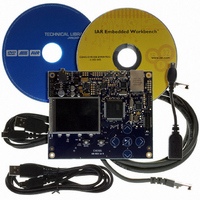ATEVK1105 Atmel, ATEVK1105 Datasheet - Page 507

ATEVK1105
Manufacturer Part Number
ATEVK1105
Description
KIT EVAL FOR AT32UC3A0
Manufacturer
Atmel
Series
AVR®32r
Type
MCUr
Datasheets
1.ATAVRONE-PROBECBL.pdf
(16 pages)
2.ATEVK1104.pdf
(826 pages)
3.ATEVK1105.pdf
(28 pages)
Specifications of ATEVK1105
Contents
Evaluation Board, Software and Documentation
Processor To Be Evaluated
AT32UC3A0512
Processor Series
AVR
Data Bus Width
32 bit
Interface Type
USART, TWI, USB, SPI, Ethernet
Operating Supply Voltage
3.3 V
Silicon Manufacturer
Atmel
Core Architecture
AVR
Core Sub-architecture
AVR UC3
Silicon Core Number
AT32UC3A0512
Silicon Family Name
AVR
Kit Contents
Board CD Docs
Rohs Compliant
Yes
For Use With/related Products
AT32UC3A0
Lead Free Status / RoHS Status
Lead free / RoHS Compliant
- Current page: 507 of 826
- Download datasheet (20Mb)
Figure 30-8. Allocation and Reorganization of the DPRAM
32058J–AVR32–04/11
U(P/E)RST.(E)PENX = 1
U(P/E)CFGX.ALLOC = 1
Pipes/Endpoints 0..5
Free Memory
Activated
PEP5
PEP4
PEP3
PEP2
PEP1
PEP0
Disabling a pipe (PENX = 0) or an endpoint (EPENX = 0) resets neither its ALLOC bit nor its
configuration (PBK/EPBK, PSIZE/EPSIZE, PTOKEN/EPDIR, PTYPE/EPTYPE, PEPNUM, INT-
FRQ). To free its memory, the firmware should clear its ALLOC bit. The k
memory window then slides down and its data is lost. Note that the following pipe/endpoint
memory windows (from k
Figure 30-8
• First, the pipes/endpoints 0 to 5 are enabled, configured and allocated in ascending order.
• Then, the pipe/endpoint 3 is disabled, but its memory is kept allocated by the controller.
• In order to free its memory, its ALLOC bit is then cleared by the firmware. The pipe/endpoint 4
• Finally, if the firmware chooses to reconfigure the pipe/endpoint 3 with a larger size, the
Note that:
Each pipe/endpoint then owns a memory area in the DPRAM.
memory window slides down, but the pipe/endpoint 5 does not move.
controller allocates a memory area after the pipe/endpoint 2 memory area and automatically
slides up the pipe/endpoint 4 memory window. The pipe/endpoint 5 does not move and a
memory conflict appears as the memory windows of the pipes/endpoints 4 and 5 overlap. The
data of these pipes/endpoints is potentially lost.
•there is no way the data of the pipe/endpoint 0 can be lost (except if it is de-allocated) as
•deactivating then reactivating a same pipe/endpoint with the same configuration only modifies
•when the firmware sets the ALLOC bit, the CFGOK bit is set by hardware only if the
memory allocation and de-allocation may affect only higher pipes/endpoints;
temporarily the controller DPRAM pointer and size for this pipe/endpoint, but nothing
changes in the DPRAM, so higher endpoints seem to not have been moved and their data is
preserved as far as nothing has been written or received into them while changing the
allocation state of the first pipe/endpoint;
configured size and number of banks are correct compared to their maximal allowed values
for the endpoint and to the maximal FIFO size (i.e. the DPRAM size), so the value of CFGOK
does not consider memory allocation conflicts.
U(P/E)RST.(E)PEN3 = 0
illustrates the allocation and reorganization of the DPRAM in a typical example.
Pipe/Endpoint 3
(ALLOC stays at 1)
Free Memory
Disabled
PEP5
PEP4
PEP3
PEP2
PEP1
PEP0
i+2
) do not slide.
U(P/E)CFG3.ALLOC = 0
Pipe/Endpoint 3
PEP4 Lost Memory
Memory Freed
Free Memory
PEP5
PEP4
PEP2
PEP1
PEP0
U(P/E)RST.(E)PEN3 = 1
U(P/E)CFG3.ALLOC = 1
Pipe/Endpoint 3
PEP3 (larger size)
Free Memory
Activated
PEP4
PEP2
PEP1
PEP0
PEP5
AT32UC3A
i+1
Conflict
pipe/endpoint
507
Related parts for ATEVK1105
Image
Part Number
Description
Manufacturer
Datasheet
Request
R

Part Number:
Description:
DEV KIT FOR AVR/AVR32
Manufacturer:
Atmel
Datasheet:

Part Number:
Description:
INTERVAL AND WIPE/WASH WIPER CONTROL IC WITH DELAY
Manufacturer:
ATMEL Corporation
Datasheet:

Part Number:
Description:
Low-Voltage Voice-Switched IC for Hands-Free Operation
Manufacturer:
ATMEL Corporation
Datasheet:

Part Number:
Description:
MONOLITHIC INTEGRATED FEATUREPHONE CIRCUIT
Manufacturer:
ATMEL Corporation
Datasheet:

Part Number:
Description:
AM-FM Receiver IC U4255BM-M
Manufacturer:
ATMEL Corporation
Datasheet:

Part Number:
Description:
Monolithic Integrated Feature Phone Circuit
Manufacturer:
ATMEL Corporation
Datasheet:

Part Number:
Description:
Multistandard Video-IF and Quasi Parallel Sound Processing
Manufacturer:
ATMEL Corporation
Datasheet:

Part Number:
Description:
High-performance EE PLD
Manufacturer:
ATMEL Corporation
Datasheet:

Part Number:
Description:
8-bit Flash Microcontroller
Manufacturer:
ATMEL Corporation
Datasheet:

Part Number:
Description:
2-Wire Serial EEPROM
Manufacturer:
ATMEL Corporation
Datasheet:










